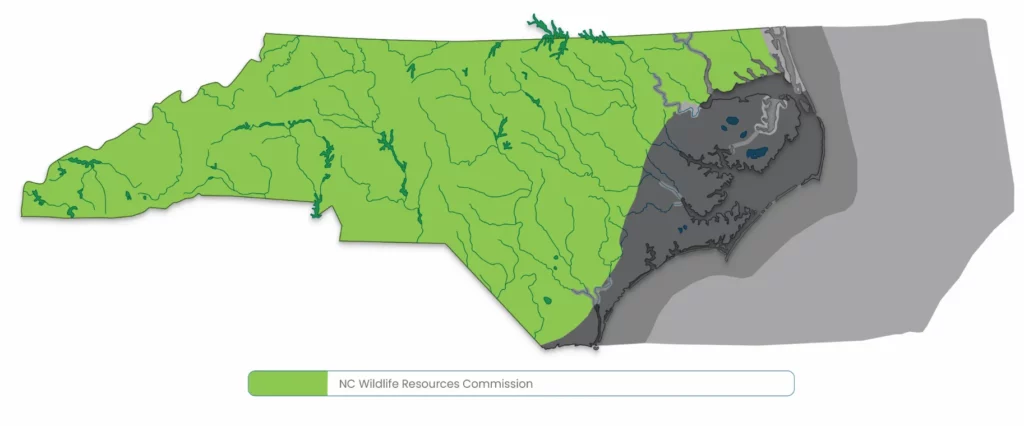North Carolina Wildlife Resources Commission (WRC)

Who They Are
The North Carolina Wildlife Resources Commission is one of two state rulemaking bodies responsible for managing jurisdictional waters within North Carolina.
The North Carolina Wildlife Resources Commission consists of 21 members. The Governor appoints nine members who represent geographic districts and serve six-year terms, and one at-large member who serves a four-year term. The General Assembly has ten appointments all serving two-year terms, with five appointed by the Speaker of the House of Representatives and five appointed by the President Pro Tempore of the Senate. The Commissioner of Agriculture appoints one member who serves a four-year term.
Where They Manage
Jurisdictional waters within North Carolina are determined by agreement between the North Carolina Marine Fisheries Commission and the North Carolina Wildlife Resources Commission. These two state agencies currently maintain three formal delineations: Coastal Fishing Waters, Inland Fishing Waters, and Joint Fishing Waters.
Inland Fishing Waters are managed under the authority of the North Carolina Wildlife Resources Commission and include all inland waters except private ponds, and all waters connecting with or tributary to coastal sounds or the ocean extending inland from the dividing line between Coastal Fishing Waters and Inland Fishing Waters as agreed upon by the North Carolina Marine Fisheries Commission and the North Carolina Wildlife Resources Commission (see 15A NCAC 03Q .0102). Certain inland game fish (such as Largemouth Bass and Sunfish) are subject to regulations by the North Carolina Wildlife Resources Commission when those species are found in Coastal Fishing Waters.
The two state agencies are currently in conflict regarding the authority and management of recreational fishing in Joint Fishing Waters.
How They Function
The Executive Director of the North Carolina Wildlife Resources Commission is hired by and serves at the pleasure of the 21-member Commission. Staff reports to the Executive Director, and staff recommendations are brought forward to the Commission for consideration and approval.
The North Carolina Wildlife Resources Commission has jurisdiction over the regulation, licensing, and enforcement of fishing in Inland Fishing Waters. The agency is not directed by Article 15 of the North Carolina General Statutes (the 1997 Fishery Reform Act) to participate formally in the planning, development, approval, or execution of fishery management plans. However, the North Carolina Wildlife Resources Commission will regularly provide biological data and staff assistance during fishery management plan development and may consider rulemaking in support of fishery management plans coordinated by the North Carolina Division of Marine Fisheries for migratory species found within its jurisdiction.
Species They Cover
Coastal migratory species jointly managed by the North Carolina Wildlife Resources Commission and the North Carolina Division of Marine Fisheries include American Eel, American Shad, Atlantic Sturgeon, Hickory Shad, River Herring, and riverine Striped Bass.
The North Carolina Wildlife Resources Commission has established rules including size limits, creel limits, and open seasons for a variety of estuarine and marine fish species when found in Inland Fishing Waters. These regulations may or may not be consistent with rules established in adjacent Coastal Fishing Waters by the North Carolina Marine Fisheries Commission; examples include Southern Flounder and Striped Mullet.

